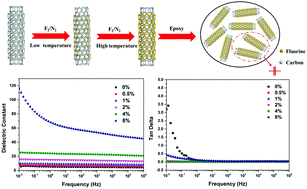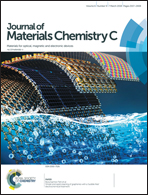Skin–core structured fluorinated MWCNTs: a nanofiller towards a broadband dielectric material with a high dielectric constant and low dielectric loss†
Abstract
This paper presents a novel skin–core structured multiwalled carbon nanotube (MWCNTs) nanofiller to enhance the dielectric performance of epoxy resin through selective fluorination of the outer shell of the MWCNTs. The outer fluorinated shells not only guarantee good dispersibility of the fluorinated MWCNTs (F-MWCNTs) in epoxy, but also prevent the direct contact of the conductive inner tubes. As a result, the inner tubes in adjacent F-MWCNTs can form abundant microcapacitors, leading to an obvious improvement of the dielectric constant of the epoxy resin with low dielectric loss. When the filler content is 8 wt%, the dielectric constant of the F-MWCNTs/epoxy composite varies from 57 at 100 Hz to 44.9 at 1 MHz, about 11.9 times and 10.8 times that of neat epoxy resin, respectively. Simultaneously, the dielectric loss maintains low values of 0.043 at 100 Hz and 0.036 at 1 MHz, respectively. The broadband high-κ and low dielectric loss demonstrate the frequency-stable dielectric behavior of the F-MWCNTs/epoxy composites, which is attributed to the suppression of the space charge polarization induced by the grafting of the strongly electronegative element fluorine onto the outer shell. We believe that the convenient preparation process and special structure will provide a new design for fabricating broadband high-κ dielectric materials with low dielectric loss.



 Please wait while we load your content...
Please wait while we load your content...